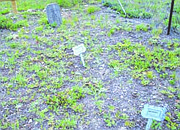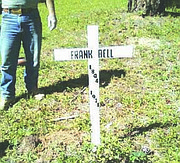Board works to restore cemetery
The cemetery board in DeBorgia has spent the last couple of years working to improve the cemetery’s grounds and overall appearance.
Ellen Matz, who heads the cemetery board, said that the cemetery became the Mineral County District 3 cemetery in April of 1956, but was in existence before then when it was owned by a private family. It is commonly referred to as the West End Cemetery or the DeBorgia Cemetery.
Matz said that up until about two years ago, the cemetery was a “place where people got buried and not much else happened” except an occasional mowing. Matz, however, said that the only care the cemetery received was when the West End Night Rider’s Snowmobile Club would come and clean up the winter downfall and debris before Memorial Day.
The cemetery board has been on paper for some time, but Matz said that its role has really changed in the last couple of years.
“And our goal is to make it a place people want to be buried again,” Matz said.
Matz said that she first got involved with wanting to make the cemetery a nicer place through American Legion.
“I got involved purely by happen stance,” she said. “I came up here four or five years ago to put flags out for Memorial Day and was absolutely aghast at the conditions of the cemetery that housed twenty-some veterans.”
Matz said that a lot of the graves made it impossible to tell who was buried where and who was who. She said that in order to determine where the veterans were buried she went to the county and no one had anything to tell her.
“And that got my investigator blood going,” Matz said.
John DuBois said that was also why he got involved. Carol Lynch said that they have property right above the cemetery and she wanted keep the area outside the fence line of the cemetery cleaned up.
“I felt it was important to improve the overall looks from inside and out,” Lynch said.
The board, whose members are representative of the different cities and geographical areas of the West End, had their work cut out for them as they started to delve into the project. Some things were easy to tend to. The old chain link fence, which was falling over in places, was replaced thanks to fencing donated by Tricon. Two cattle gates were placed at the entrance to the cemetery thanks to donations and a wooden archway was installed over the entrance. They paid to have unwanted trees removed as well as stumps. A flag pole was installed and a shed was also placed out on the cemetery grounds.
“We had very little come out of our budgetary funds,” Matz said.
The larger problem at hand was the issue of grave sites. The group didn’t know where graves were when they started and many were unmarked or markers had faded due to age. Matz said that had trouble finding graves for people who were supposed to be in the cemetery and found graves that weren’t on the list. In some cases, graves only have the first name of a person.
“We had a lot of graves with no headstones, some with rocks, some were worn to a frazzle,” DuBois said.
After some effort, the board finally got a hold of a diagram that list of the known graves in each row. Working from death records and with the Mineral County Museum, Matz and Lynch started to gather information of the cemetery’s ‘residents.’
“We have some graves where we may never know who they are,” Matz noted, “but it’s someone’s final resting place and we want to be able to mark it. Once we started doing this, people have come out of the woodwork with stories about people they know who are out there.”
The board are using white crosses, made from a Engleman Spruce that was felled in Big Creek some 20 years ago by a couple from over in Spokane who overheard about the project while the board was meeting in the O-Aces.
Matz said that the crosses aren’t replacing original grave markers as they don’t want to disturb the site, but the cross is a supplement to a rock that might just be scratched with a name. Matz said that as they discover more information about a particular person they will add it to the grave marker.
“I think we’re doing this to show a little respect for people,” said Carola Jackson, board member. “I mean, there certainly isn’t any profit in this. We’re not doing this for money…it needed some care and no one was doing it.”
The board has been getting help with piecing information about graves and the people in the cemetery from a lady in Arizona who has relatives in the cemetery, Denise Crawford. Matz said that they have been emailing her and got into contact with her after someone mentioned that the DeBorgia Cemetery was on the internet.
“And I was like you would think someone on the board would know about this,” Matz said. “But I found out her email, emailed her and we’ve been sharing information now. We started from death records and just working through them and some cool things have come out of this project.”
Matz said that down the road they’d like to have an archaeological team from Missoula or somewhere come do some work as the cemetery was along part of the Mullan Trail and there were also people moved from other areas of burial when I-90 went through.
DuBois said that at first some people were concerned when they started to take care of the neglect. He said they were worried that it would destroy the essence of its country charm.
“But it does still look like a country cemetery,” DuBois said. “It’s not as perfect as some, but it’s country and that is its charm.”
Aside from bringing the cemetery back from neglect, the board has also developed regulatory controls. DuBois said that it does not cost to bury someone in the cemetery and that in past years, five to ten years ago, people would just go “out in the middle of the night to bury Uncle Fred.”
Matz said that they also read about this is past articles during research, but have now put up signs. They also don’t just want the cemetery to be open to anyone because people will take advantage of the fact that it doesn’t cost anything.
In reference to deciding who can be buried in the cemetery and making policy, Matz said that “try to keep the interest of community in mind.”
Matz said that the board will review anyone who wishes to have a loved one buried in the cemetery. She said that individuals being buried in the cemetery should have ties to the community, but noted that they will look at individual cases because if someone’s family is buried there, but they are from out of state, that makes a difference.
The cemetery doesn’t receive much in the way of funds and so in hoping to offset some costs, they are going to have a few boxes made for cremation ashes. They are also planning to sell coffee at the rest area in the West End to raise funds.
“I feel like ever since we started to take care of the cemetery more families have really started to tend to the graves of their loved ones,” Matz said.
The cemetery sits on two acres and is at about 36 percent occupancy. She said that they can always use volunteers especially as the spring weather allows them to get back out to work again. She said that they still have a few more things they’d like to acquire for the cemetery including a light for the flag pole.
Matz said that she feels that in the next couple of years she believes the cemetery will get to a place where it will look as good as it can and in terms of getting people identified. She encourages anyone with any information about those buried in the cemetery that they would love to hear from them.
She also invited anyone interested in what the board is doing to attend the meetings that are held on the first Thursday of every month at 2 p.m.
For more information, Matz can be reached at 678-2078.





